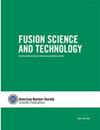Thermal Effects on Dynamic Behavior of CFETR Vacuum Vessel
IF 0.9
4区 工程技术
Q3 NUCLEAR SCIENCE & TECHNOLOGY
引用次数: 0
Abstract
AbstractThe vacuum vessel (VV) of the China Fusion Engineering Test Reactor (CFETR) was designed to withstand the variable structural loads resulting from dynamic excitation, such as seismic and plasma disruption. Modal analysis, a powerful tool, was used to evaluate the structural dynamic characteristics, such as frequency and mode shape. In addition, the CFETR VV has three different temperature conditions: room temperature (20°C), normal operation temperature (100°C), and baking temperature (200°C).In this paper, in order to investigate the influence of such different temperature conditions to the dynamic behavior of the VV, three independent finite element analysis with the same modal analysis method were performed. According to analysis results, there are obvious thermal effects on the dynamic behavior, such as nature frequency and mode shape, among the different temperature cases for the CFETR VV. Moreover, the results show that the natural frequency for each order decreases as the temperature increases, and the mode shape of the VV also changed with temperature.Keywords: CFETRvacuum vesselfinite elementmodal analysisthermal effect AcknowledgmentsThe authors are grateful to those who have given helpful advice. We would like to express our gratitude to the referees for information and suggestions that helped the quality of this paper significantly.Disclosure StatementNo potential conflict of interest was reported by the authors.Additional informationFundingThe research is supported by the National Key R&D Program of China (2017YFE0300500).热效应对CFETR真空容器动力性能的影响
摘要中国核聚变工程试验堆(CFETR)的真空容器(VV)设计能够承受地震和等离子体破坏等动力激励引起的可变结构载荷。模态分析是一种强有力的工具,用于评估结构的动力特性,如频率和模态振型。此外,CFETR VV有三种不同的温度条件:室温(20℃)、正常工作温度(100℃)和烘烤温度(200℃)。为了研究这些不同温度条件对VV动力性能的影响,本文采用相同的模态分析方法进行了三次独立的有限元分析。分析结果表明,不同温度工况下CFETR VV的固有频率和模态振型等动态特性均存在明显的热效应。结果表明,随着温度的升高,VV各阶固有频率减小,模态振型也随温度的升高而变化。关键词:真空容器;有限元;模态分析;热效应;我们要对审稿人提供的信息和建议表示感谢,这些信息和建议对本文的质量有很大帮助。披露声明作者未报告潜在利益冲突。本研究得到国家重点研发计划项目(2017YFE0300500)的支持。
本文章由计算机程序翻译,如有差异,请以英文原文为准。
求助全文
约1分钟内获得全文
求助全文
来源期刊

Fusion Science and Technology
工程技术-核科学技术
CiteScore
2.00
自引率
11.10%
发文量
60
审稿时长
3 months
期刊介绍:
Fusion Science and Technology, a research journal of the American Nuclear Society, publishes original research and review papers on fusion plasma physics and plasma engineering, fusion nuclear technology and materials science, fusion plasma enabling science technology, fusion applications, and fusion design and systems studies.
 求助内容:
求助内容: 应助结果提醒方式:
应助结果提醒方式:


